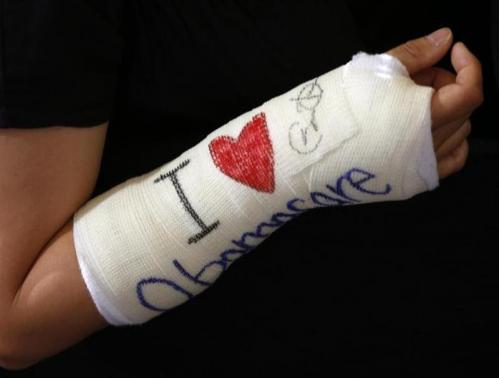(Reuters) – Last summer, White House officials planning a nationwide push to urge young adults to enroll in new health insurance plans had a big problem: Polls showed that many young, healthy people who could be key to the success of the Affordable Care Act knew little about it or its October 1 rollout.

So the administration, scrambling to create a publicity “buzz” that would ripple across social media, turned to Hollywood. Stars such as pop singer Lady Gaga – a Twitter icon with nearly 41 million followers – singer John Legend (5 million followers) and actress Olivia Wilde (1.2 million followers) tweeted messages urging their fans to “get covered” by the program known as Obamacare.
The tweets faded quickly, though, when it became clear that the launch of the Obamacare website designed to enroll millions of Americans was a disaster that threatened the viability of President Barack Obama’s signature domestic achievement.
Now, with the HealthCare.gov website functioning better and enrollment deadlines for 2014 looming, the White House and its allies are making an urgent new pitch to “young invincibles” who may question whether they need health coverage.
This time, the pitch focuses less on celebrity messengers and more on casting Obamacare coverage as more affordable than many young people might think, particularly if they qualify for federal subsidies. It also seeks to nudge young adults into action by portraying insurance as a social responsibility, and encouraging peers and parents to put pressure on the uninsured.
A key goal of the media push is reversing what polls suggest is rising disillusionment toward Obamacare among young adults, who have become more familiar with the healthcare law through unflattering reports about the website’s woes and a drum beat of ads from conservative groups calling the program a fiasco.
In essence, the administration and its allies are trying to recast Obamacare as a consumer issue, rather than a political one. That is an enormous challenge, advocates acknowledge, at a time when Republicans are pursuing congressional investigations of Obamacare’s launch and vowing to make dissatisfaction with Obamacare their top issue in next year’s elections, when control of Congress will be at stake.
For Obama and his legacy, the stakes are huge in the campaign to reach young adults.
However many people sign up for Obamacare for 2014 – the non-partisan Congressional Budget Office’s estimate of 7 million now appears too optimistic, given the website’s problems – about one-third or more will need to be young, healthy adults whose payments into the system would help offset the costs of covering older, sicker people who require more care.
The task of signing up enough young people could be even tougher because the White House decided on Thursday to exempt hundreds of thousands of Americans from the new law’s requirement that they buy health insurance.
Those who have had their current policies canceled because they do not meet the standards of the new law will be allowed to buy a bare-bones plan or go without insurance in 2014.
If Obamacare does not enroll enough “young invincibles,” analysts warn the program could face a financial “death spiral.” Insurers would need to raise premiums to pay for covering a sicker population. That could deter young people from enrolling, and private insurers would lose their incentive to participate.
The White House and its allies will need to enroll young adults like Michael Baratta, 30, a day trader from Tucson, Arizona. Baratta said that when the HealthCare.gov site launched, he tried for days to shop for coverage, but gave up.
Baratta said he plans to try again once he’s more confident the website’s glitches have been ironed out.
In a troubling sign for Obamacare, a recent Harvard University poll suggested that young people were souring on the program, with 57 percent saying they disapproved of it. In the poll of 18-to 29-year-olds, fewer than 3 in 10 who were uninsured said they definitely or probably would enroll.
“The program is built on the assumption that healthy people will have an incentive to come into the healthcare system. We don’t really know if that’s going to work yet,” said Elaine Kamarck, a domestic policy analyst at the Brookings Institution.
“The bottom line is going to be: Do the economics work for these young people?”
‘TELL A FRIEND’
Putting a sunny face on that question – and generating conversations about young adults and healthcare – is at the core of the administration’s stepped-up effort to get uninsured adults ages 18-34 to sign up for coverage.
On Wednesday, Obama and his wife Michelle hosted a group of mothers at the White House to talk about healthcare, a meeting meant to symbolize the administration’s hope that parents will encourage their adult children to get coverage.
But most of the new enrollment push for young Americans is being carried out by advocacy groups in one-on-one discussions that emphasize the economics and security of health insurance.
The “Tell a Friend – Get Covered” campaign, sponsored by Covered California and the advocacy group Enroll America, aims to promote healthcare conversations among friends and neighbors.
One video made for the campaign features a montage of young people, including a woman at a bus stop who suddenly begins wheezing and a man who takes a spill on a mountain bike. The message: Young people can be quite vulnerable without insurance.
Generation Progress, a Washington, D.C.-based group focused on youth issues, has published blogs aimed at explaining the health law. A recent post touted tax credits available under the law and benefits such as free preventive care for women.
One of conservatives’ complaints about the law is that it requires young people who have had inexpensive, bare-bones coverage to upgrade into costlier plans that feature benefits some young adults may never use, such as maternity care.
With costs in mind, a group called Young Invincibles has launched a mobile app that allows people to calculate the federal subsidies they would receive if they bought health insurance through HealthCare.gov’s marketplace.
Other blogs linked on Twitter and Facebook tout people who have gotten good deals on insurance through Obamacare.
They include a pregnant woman from California who will pay only $34 a month for coverage, and a Miami waiter who got a plan for $145 a month after going two years without insurance.
Conservative groups such as Generation Opportunity, which gets money from the billionaire brothers Charles and David Koch, continue to hold events on college campuses to urge students to reject Obamacare as a law that limits healthcare choices.
Conservatives have ridiculed some of the work by Obamacare supporters. Their target this week was a tweet by Organizing for Action, a group aligned with Obama’s administration.
The tweet included a photo of a young man wearing plaid pajamas next to a message that read, “Wear pajamas. Drink hot chocolate. Talk about getting health insurance.”
Mocking references to “Pajama Boy” swept across social media, as conservatives lampooned the man as a slacker.
‘SPIN’ and ‘GIMMICKS’
One difficulty in forecasting enrollment by young people is that many tend to procrastinate. The White House has cited the experience of Massachusetts, whose healthcare program was a model for Obamacare. Officials note that many young adults in Massachusetts waited until the deadline to initially sign up.
For Obamacare, two key deadlines are looming. Those who want coverage to begin on January 1 need to sign up by Monday, although some states have indicated they will extend that deadline. By March 31, most Americans must have health coverage or face penalties that start at $95.
Despite the threat of penalties, many young adults remain on the fence when it comes to Obamacare.
They include Michael McBride, 34, a restaurant manager from St. Louis who gets no insurance from his employer and is worried about the cost of Obamacare coverage. He said that on his annual income of about $40,000, that might be tough to afford. He said he makes too much to qualify for a significant subsidy.
“I’m still looking at $100 or $200 a month, and that’s outrageous,” McBride said, adding that he still might enroll.
“I’m probably going to be late on the wagon there,” he said.
Jonathan Wilcox, a communications specialist at the University of Southern California who has advised Republicans, said that disapproval of the healthcare law – which stood at 57 percent in a Reuters/Ipsos poll released Friday – is a big challenge for the White House.
He said the outreach to young adults amounted to “spin” and “gimmicks” that “don’t encourage young people to do what’s best for them. They urge them to do what’s best for Obamacare.”
Anne Filipic, president of Enroll America, said she doubts conservatives’ criticism will deter young adults from enrolling.
“We’re not focused on the politics,” she said. “We’re focused on, what does this actually mean to you as a consumer? What are the options available to you?”
(Additional reporting by Curtis Skinner, Caroline Humer and Lewis Krauskopf in New York and Roberta Rampton in Washington; Editing by David Lindsey, Ross Colvin and Ken Wills)





